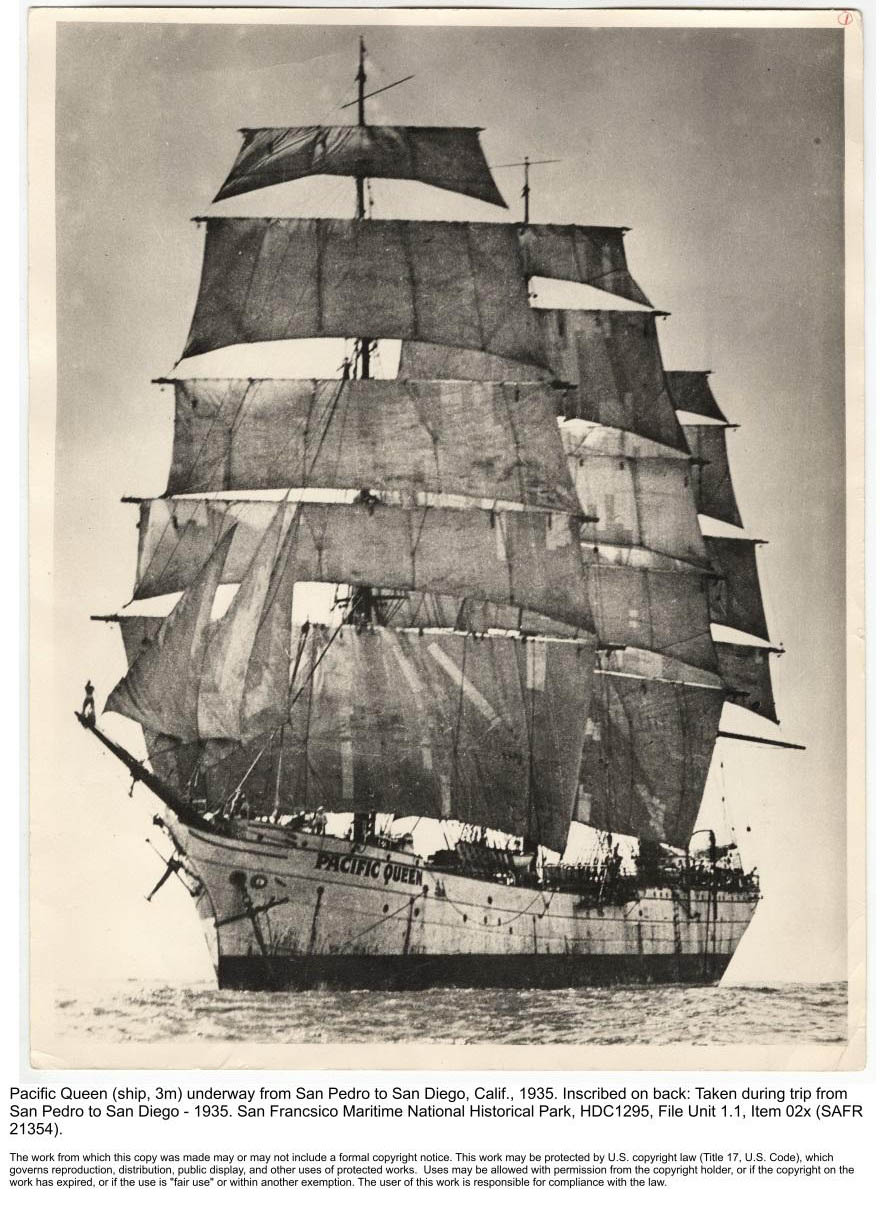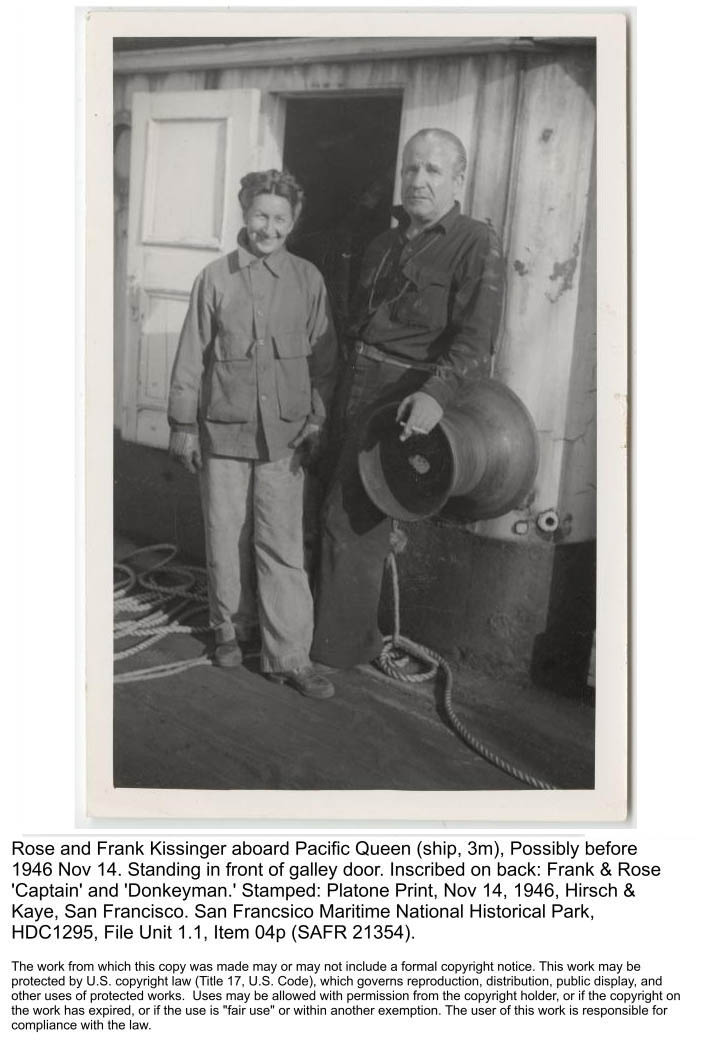
A ship without a job is headed for the scrap yard. Back in the early 1930s, this described the Alaska Packer’s fleet of sailing ships. They were slowly being sold off for scrapping and to be repurposed as barges. However the vessels also fed dreams even sitting at Fortmann’s Basin in Alameda, inspiring a young Karl Kortum and his friend Harry Dring to become Cape Horn sailors. Years later, this passion eventually led Kortum to establish the San Francisco Maritime Museum and collect the vessels we care for here today.
Jack McGinty dreamed of seafaring as well and he was also willing to do practically anything to get to sea. He bounced from job to job, working his way up to San Francisco in a steamer, then working in the Star of Scotland, and a fishing barge moored in Santa Monica Bay. He also worked for Frank Kissinger in his used car lot on Figueroa Street, and talked his way into the adventure when he heard Frank and his friend Bill Chrysler were going to buy one of the old Alaska Packers ships. Thanks to McGinty’s recollections, preserved here at the J. Porter Shaw library, we have a much fuller picture of the Kissingers’ acquisition and early ownership of Pacific Queen. McGinty’s own adventures are interesting reading as well, and a window on the dreams of a whole generation, fed on the tales of the last of the windjammers as people like Alan Villiers and Exy and Irving Johnson wrote of their travels. These vessels must have seemed to be the last great adventures to be had, since the world had by now been fully “discovered,” and the ocean was the only frontier left to test young bodies and minds.
According to McGinty, Frank Kissinger was a showman. His dreams weren’t of ships and the sea, but of money. He was looking for a property to show, something that would keep the dollars coming in. He met a former windjammer captain named Chad Lee in the Hotel Continental, a place that catered to the entertainment industry. Late one night, while talking of ways to make money, his ears pricked up as the good captain said that the last of the old full rigged ships would make the best show property imaginable.
Rose met Frank Kissinger in a hotel in Los Angeles. How she got there is murky. Her voice is sadly muted in the telling of her own story. She is quoted in newspaper articles and there is one script of a radio interview. Her scrapbook shows typewritten tryouts of a title and byline of a book called Caught With Her Sails Down,” a book that is also described as forthcoming in newspaper articles of the 1940s, but was never published. Karl Kortum’s papers contain a tantalizing few pages with a handwritten label reading “Abstract from Mrs. K’s mss.” In it, her meeting with Frank Kissinger reads in part:
“Met Rose during this period at another hotel where she was staying, owned by a friend, whom she occasionally assisted in the capacity of telephone operator.” A 1953 newspaper article describes her as,
“a country schoolmarm who saved her money for a sightseeing trip to Hollywood. She spent her savings and found a job as a telephone operator in a hotel catering to show folks, traveling salesmen, con men, grifters and assorted other carnies. It was there she met and married Frank.”
Though the details are unclear, what is certain is that she and Frank joined forces. He sold his business and they went north to Alameda to buy one of the last of the Alaska Packers fleet. Jack McGinty went with them, as well as Captain Lee, a fellow showman named Bill Chrysler, and a couple of employees from Kissinger’s used car lot.
The Kissingers hired the best help they could find. Captain Lee washed his hands of them quite quickly, and they hired Captain Charles Watts, a Cape Horner who, incidentally, tried to sign Karl Kortum on as part of his boy crew to sail the Star of Zealand to Japan for scrapping. He sailed the Pacific Queen to San Pedro but also parted company with the Kissingers when they cast off the lines and forced him into sailing Pacific Queen up to Santa Monica Bay.
The Kissingers bounced from dock to dock, trying to make a living, and especially in the first year or so as they were pushed to the limit of their resources. The following eighteen years were a series of adventures. The first big break was renting the Pacific Queen to MGM for the making of the movie Mutiny on the Bounty. Roy Moyes, Captain Watts’ first mate on the first voyage down the coast, was hired as captain by MGM. He stayed on to sail the vessel with crews of Sea Scouts. The vessel’s first cruise in 1935 went quite well. The second in 1936 was disastrous. The original plan was to trap sea lions in Mexico to sell to zoos, however it was called off after the first attempt. The cage of chicken wire failed and a boy was nearly killed. The ship was repeatedly becalmed on the trip back, and food ran low. The boys lived on lima beans between the provisions the Kissingers were able to buy from passing ships. After 67 days, Pacific Queen arrived back in San Diego, having had to accept a tow from the Coast Guard. The newspaper reports were favorable, however, and one of the boys even wrote a series of newspaper articles about the trip. It was the last time Pacific Queen sailed however.
For the next sixteen years, the ship was towed up and down the coast, kicked from berth to berth. They returned to San Francisco Bay for the 1939 World’s Fair and enjoyed a brief bout of prosperity, but World War II saw them shunted to out of the way berths in Richardson Bay, Islais Creek, and, in an odd foreshadowing of the present day, a short stay at Hyde Street Pier. During this time, Rose took a course in celestial navigation and ended up teaching the subject for the Navy as male instructors filtered into the Armed Forces. She invented a teaching aid, a celestial sphere that the Navy helped her patent, and a time indicator, an example of which is in the J. Porter Shaw archives.
All things come to an end though and Pacific Queen was resting on the mud flats in Sausalito when Frank Kissinger died of a heart attack. Rose Kissinger entered into negotiations with the newly formed Maritime Museum soon after. She drove a hard bargain, but in the end, Karl Kortum’s new organization closed the deal. Today, Balclutha and the rest of the vessels of San Francisco Maritime National Historical Park are the last tall masts to grace the waterfront of San Francisco.
Rose and Frank Kissinger were not sailors in any sense of the word. They were utterly unaware of the magnitude of the task they had taken on and yet they managed to stay aboard Pacific Queen for twenty years, longer than anyone else who had ever owned or sailed her. They acquired Star of Alaska at a time when all her square-rigged sisters were being scrapped, cut down for barges, or simply left to rust away. The creativity and ability of the Kissingers to stay one step ahead of the maintenance and the authorities ensured Balclutha’s survival in an era when she was an expensive white elephant. They weren’t the first couple to buy more boat than they could handle, and they will not be the last. Balclutha owes her survival to these two colorful rogues.

